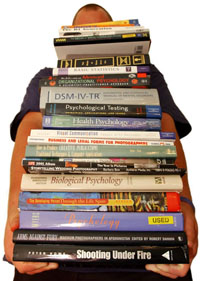Essay Writing 101
I’ll keep this short and to the point, because that’s what you want. Whether you started your paper a week before the deadline or the night before, you have a giant pile of books to read. Even a second year paper will likely require ten or more sources, which can be pretty daunting when you get those books stacked up next to your desk. Today you’ll learn a process to make that a lot easier, and help you research more efficiently. This doesn’t replace reading the books or articles, but it’s a good way to sort which ones are beneficial for you. I’ll go through it step by step.
1. Get a Bunch of Books, Look at the Titles
 Find a bunch of books and journal articles that look like they’re related to your topic. Try for thirty or forty, and cast a really wide net. Grab anything that might even be tangentially associated. Put them all in a pile, or in a window in your browser.
Find a bunch of books and journal articles that look like they’re related to your topic. Try for thirty or forty, and cast a really wide net. Grab anything that might even be tangentially associated. Put them all in a pile, or in a window in your browser.
2. Read the Short Version
If it’s a paper, read the abstract, the introduction, and the conclusion. If it’s a book, read the table of contents. If you can’t find anything in there that relates to your topic, toss it aside. It had a catchy title, but it’s ultimately useless for you. consider reading it for fun. If there’s a section that does relate to your topic, go to it and read the introduction and the conclusion. This will give you a good picture of what the author’s views are, and what the point of the chapter is. If it doesn’t relate to your topic, toss it aside. Catchy chapter title, but you don’t care.
3. Keep the Gold
Now you should only have books and articles that relate to your topic, or with sections that relate. Those you have to actually read, but you’ve probably shaved your pile down from forty books to ten, and the ten books are actually good for you. Read these, and use the next step.
4. Mark It Up
Any time you find a sentence or an argument that hits something you want to say, copy it down and cite it. Make sure to cite it. This will keep you from having to go back later. Do this for every book, while keeping your argument in mind. Now you have a bunch of great points to cite. Don’t just take the ones that agree with you, either. Good points that disagree with your conclusion are often worth more.
5. Bibliographile
If your book list is lean, then during step 4, make a note of what your book is citing, and go and find those sources. Remember, you’re part of a tradition. The people you’re reading had to write these same papers, and they’re having a dialogue with the scholars who came before them. use that to your advantage by expanding your research to include them.
And that’s it. You go from a giant pile of books and articles to a small amount which are all useful, without having to read each entire book to do it. Remember, even if you wind up getting rid of the quotes from a book that you read, it goes in your bibliography. It’s influenced and shaped your paper., and shows the breadth of your research. This only applies to books from step 3, though.
Do not do this with primary sources. I’ll repeat that, just so we’re 100% clear. DO NOT DO THIS WITH PRIMARY SOURCES. Don’t even try. Plato or Herodotus will not make sense if you do this. That stuff you have to just straight up read. the same is true of really challenging or technical texts. A lot of the relevant details there are in the subtleties, which you’ll miss in a skim. Be aware of what you’re doing, and if you feel like you’re missing things, you probably are.
So if you’re just reading the introduction and conclusion to this post, you know that I set out to teach you how to reduce books to a manageable number while saving you a lot time on your research, and that’s exactly what I did. If you read the whole thing, you know that, and well done. These steps will save you a lot of grief, though they will cost you. Reading a lot of books will make you a better rounded scholar, but sometimes you just don’t have the time.
Do you have more essay and research tips? Leave them in the comments!
